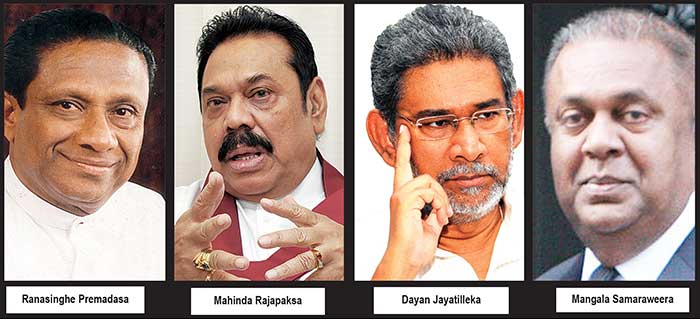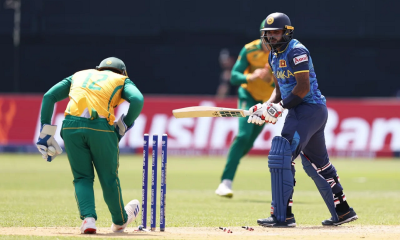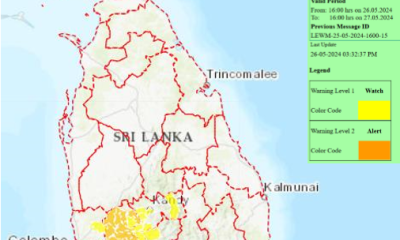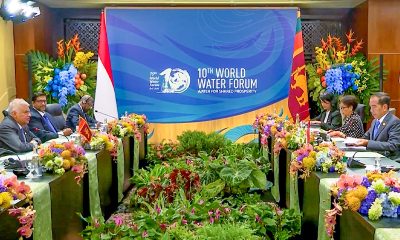Features
The centre that no longer holds

By Uditha Devapriya
Ranasinghe Premadasa’s policies broadly targeted two variables, growth and equity. His government did not view them as contradictory and oppositional. Instead, it framed them as complementary and concomitant. With that, it effectively squared the circle.
Premadasa was Sri Lanka’s first centrist, its only centrist. Yet today the Premadasa notion of centrism, in politics and economics, has been abandoned. During Premadasa’s time parties that identified themselves with progressive causes shifted to the right, justifying the shift on electoral grounds: if they did not tilt, they reasoned, they risked losing support. The Labour Party in the UK and the Democrats in the US were among the first to make this move. Two years after Premadasa’s murder, the SLFP followed suit. The People’s Alliance, headed by the SLFP, threw Premadasa’s reforms to the dustbin. They focused on a new paradigm, a new set of policies. They called it structural adjustment with a human face.
In foreign policy too, there were major transformations. As the UNP’s presidential candidate Premadasa had prioritised two things: getting the IPKF out and defusing separatist tensions in the north and the insurrection in the south. These were all interconnected, and the new government realised that they could not be resolved in isolation from each other: they had to be viewed on a continuum, and they had to be addressed jointly. A key aspect of this was the country’s commitment to Global Southernism, which had won it a high place in the 1970s. Premadasa sleekly attempted to restore this aspect of Sri Lanka’s foreign policy, after it had been squandered by his predecessor on the pretext of getting closer to the West. The People’s Alliance government more or less abandoned that.
Thus, in domestic politics and foreign policy, successive governments after 1994 neglected if not undermined the Premadasa legacy, his notion of centrism.
Centrism in Sri Lanka today evokes, not the Premadasa paradigm, but the paradigms of two distinct political groups. First, the People’s Alliance. The People’s Alliance ostensibly sought a compromise between the UNP’s neoliberal policies and the SLFP’s centre-left credentials. This was merely window dressing for a capitulation to the right. It accompanied a broader shift within progressive circles, a shift which Rajiva Wijesinha describes in Representing Sri Lanka: by 1994, liberal groups that had once associated with progressive, centre-left politics, had yielded place to what he calls the “advocacy of wholesale withdrawal by the state from the social services necessary to develop a level playing field.”
The policy shift of the People’s Alliance had a purpose and a justification. Its purpose was ostensibly to liberalise the economy and its justification was that three decades of socialist experimentation had not delivered, particularly in a context where the Soviet Union, the crucible of world socialism, had collapsed. This turnaround spilt over to the country’s foreign policy: the People’s Alliance and the opposition UNP advocated a shift away from Global Southernism, in line with calls, articulated by powerful countries along with powerful foreign interests, to do away with organisations that had been the lifeblood of Global Southernism. Gamani Corea, whose advocacy of the Global South is yet to be equalled by a mainstream economist here, including those who claim to carry forward his legacy institutionally, spoke for many when he rubbished calls to abolish groups like NAM.
“You very rightly, Hon. Minister [Lakshman Kadirgamar], pointed out that NAM continues to retain its relevance despite the changed global scene. Many ask: since the Cold War has ended what is now the continuing relevance of NAM? They do not ask this about NATO however. NATO was nothing but a child of the Cold War. Yet NATO continues, and is being transformed to play a new role. But of NAM we are asked: why should you continue? What is your relevance? I think the answer is that NAM is an association of developing countries devoted to identifying and pursuing their common interests.”
Two developments contributed to this new status quo. The first was the passing away of an that generation of intellectuals, especially economists, who had been far more radical and assertive in their advocacy of Third World solidarity and nonalignment, and far more critical of orthodox neoliberal theory, than today’s lot. The second was the mushrooming of think-tanks and civil society groups which, if they did not endorse orthodoxy to the hilt, at least accepted it as the only plausible alternative. This is why civil society today, despite opposing political authoritarianism, is yet to take a definitive stand against the economic paradigms that tend to be marshalled in defence of such authoritarianism. That is why few economists today do not dare critique orthodox paradigms, or address their limitations.
This combination, of being critical of political authoritarianism and lackadaisical about the economic paradigms used in defence of such authoritarianism, is symptomatic of a broader malaise in our society: the deterioration of intellectual standards and the complicity of the intellectual elite in that same authoritarianism they so wilfully, and self-righteously, deplore. More specifically, I think it reveals a failure to integrate economics and politics, or to realise that economics was, in fact, once known as political economy. A simple example would be the establishment’s critique of the State clamping down on trade unions, versus its advocacy of liberal labour laws. I think Lakmali Hemachandra’s critique here is spot on.
“Employers’ proposals are predictably aiming at repealing legal protections enjoyed by workers and if entertained will completely leave the workers at mercy of the unilateral power of their employers without adequate bargaining power or state protection. The outcome of these proposals will be nothing but increased job insecurity and wage insecurity among workers already struck by rising cost of living eating into their real wages.”
Or as Dayan Jayatilleka observes in a recent DailyFT column,
“Labour laws cannot be scrapped without a major confrontation with organised labour. Land reforms were introduced by the Sirimavo administration as a response to the 1971 insurrection and were supplemented by President Premadasa’s Task Force on the Redistribution of state lands to the landless, after the second (1986-1989) insurrection. Reversing those laws and facilitating corporate agriculture on a small island creates pressure on the land, generate landlessness and sows the seeds of rural rebellion.”
All these contradictions and convulsions can, I think, be traced to a simple problem: the absence of a proper, progressive centre in our political space. The Ranasinghe Premadasa notion of centrism gave way to the People’s Alliance notion of structural adjustment with a human face. The Mahinda Rajapaksa administration reversed some of the more onerous policies of this paradigm, notably decades of privatisation: a policy that had entrenched the corrupt. Yet after a while it too embarked on policies that hardly differed from neoliberal orthodoxy. Meanwhile, the backlash against the Rajapaksas gained momentum, leading to a revival of centrism of another sort. This centrism can best be identified, not with the UNP, but with the Radical Centre, spearheaded by Mangala Samaraweera.
The politics and economics of the Radical Centre have been critiqued by different people from different perspectives. There is no need to recapitulate all of them here. My critique of the Radical Centre is the same as my critique of the post-1994 wave of centrism overseen by the People’s Alliance: that it accepted, even fought for, political liberalism, but overlooked the fundamental contradiction between the imperatives of political liberalism and economic liberalism. The latter was accepted by the People’s Alliance, mutedly endorsed by the (later) Rajapaksa administrations, and revived by the yahapalana regime. The Radical Centre, while critiquing the authoritarian excesses of the Rajapaksa government, failed to note just how aligned such authoritarianism was with the economic ideals its leader valorised, especially when he held important posts in the yahapalana regime. This is a contradiction that liberal ideologues do not seem to bother themselves with today.
What is urgently needed now, as Dayan Jayatilleka points out in another recent column, is a shift to a progressive centre. If we achieve this shift, he argues, we will be able to not only counter the preachers of orthodoxy, who remain complicit in the authoritarian machinations of the regime, but also pre-empt those promoting Manichean political visions on the pretext of convincing voters of being the only alternative out there. What is needed, in other words, is a new Radical Centre: one which invokes, not the People’s Alliance’s or the present Radical Centre’s flirtations with half-baked liberalism, but the policies of the only real centrist leader this country had, Ranasinghe Premadasa. Curiously, it is this very centrist leader who doesn’t get so much as a mention by Sri Lanka’s ubiquitous, self-avowed centrists.
The writer is an international relations analyst, researcher, and columnist who can be reached at udakdev1@gmail.com.
Features
The heart-friendly health minister

by Dr Gotabhya Ranasinghe
Senior Consultant Cardiologist
National Hospital Sri Lanka
When we sought a meeting with Hon Dr. Ramesh Pathirana, Minister of Health, he graciously cleared his busy schedule to accommodate us. Renowned for his attentive listening and deep understanding, Minister Pathirana is dedicated to advancing the health sector. His openness and transparency exemplify the qualities of an exemplary politician and minister.
Dr. Palitha Mahipala, the current Health Secretary, demonstrates both commendable enthusiasm and unwavering support. This combination of attributes makes him a highly compatible colleague for the esteemed Minister of Health.
Our discussion centered on a project that has been in the works for the past 30 years, one that no other minister had managed to advance.
Minister Pathirana, however, recognized the project’s significance and its potential to revolutionize care for heart patients.
The project involves the construction of a state-of-the-art facility at the premises of the National Hospital Colombo. The project’s location within the premises of the National Hospital underscores its importance and relevance to the healthcare infrastructure of the nation.
This facility will include a cardiology building and a tertiary care center, equipped with the latest technology to handle and treat all types of heart-related conditions and surgeries.
Securing funding was a major milestone for this initiative. Minister Pathirana successfully obtained approval for a $40 billion loan from the Asian Development Bank. With the funding in place, the foundation stone is scheduled to be laid in September this year, and construction will begin in January 2025.
This project guarantees a consistent and uninterrupted supply of stents and related medications for heart patients. As a result, patients will have timely access to essential medical supplies during their treatment and recovery. By securing these critical resources, the project aims to enhance patient outcomes, minimize treatment delays, and maintain the highest standards of cardiac care.
Upon its fruition, this monumental building will serve as a beacon of hope and healing, symbolizing the unwavering dedication to improving patient outcomes and fostering a healthier society.We anticipate a future marked by significant progress and positive outcomes in Sri Lanka’s cardiovascular treatment landscape within the foreseeable timeframe.
Features
A LOVING TRIBUTE TO JESUIT FR. ALOYSIUS PIERIS ON HIS 90th BIRTHDAY

by Fr. Emmanuel Fernando, OMI
Jesuit Fr. Aloysius Pieris (affectionately called Fr. Aloy) celebrated his 90th birthday on April 9, 2024 and I, as the editor of our Oblate Journal, THE MISSIONARY OBLATE had gone to press by that time. Immediately I decided to publish an article, appreciating the untiring selfless services he continues to offer for inter-Faith dialogue, the renewal of the Catholic Church, his concern for the poor and the suffering Sri Lankan masses and to me, the present writer.
It was in 1988, when I was appointed Director of the Oblate Scholastics at Ampitiya by the then Oblate Provincial Fr. Anselm Silva, that I came to know Fr. Aloy more closely. Knowing well his expertise in matters spiritual, theological, Indological and pastoral, and with the collaborative spirit of my companion-formators, our Oblate Scholastics were sent to Tulana, the Research and Encounter Centre, Kelaniya, of which he is the Founder-Director, for ‘exposure-programmes’ on matters spiritual, biblical, theological and pastoral. Some of these dimensions according to my view and that of my companion-formators, were not available at the National Seminary, Ampitiya.
Ever since that time, our Oblate formators/ accompaniers at the Oblate Scholasticate, Ampitiya , have continued to send our Oblate Scholastics to Tulana Centre for deepening their insights and convictions regarding matters needed to serve the people in today’s context. Fr. Aloy also had tried very enthusiastically with the Oblate team headed by Frs. Oswald Firth and Clement Waidyasekara to begin a Theologate, directed by the Religious Congregations in Sri Lanka, for the contextual formation/ accompaniment of their members. It should very well be a desired goal of the Leaders / Provincials of the Religious Congregations.
Besides being a formator/accompanier at the Oblate Scholasticate, I was entrusted also with the task of editing and publishing our Oblate journal, ‘The Missionary Oblate’. To maintain the quality of the journal I continue to depend on Fr. Aloy for his thought-provoking and stimulating articles on Biblical Spirituality, Biblical Theology and Ecclesiology. I am very grateful to him for his generous assistance. Of late, his writings on renewal of the Church, initiated by Pope St. John XX111 and continued by Pope Francis through the Synodal path, published in our Oblate journal, enable our readers to focus their attention also on the needed renewal in the Catholic Church in Sri Lanka. Fr. Aloy appreciated very much the Synodal path adopted by the Jesuit Pope Francis for the renewal of the Church, rooted very much on prayerful discernment. In my Religious and presbyteral life, Fr.Aloy continues to be my spiritual animator / guide and ongoing formator / acccompanier.
Fr. Aloysius Pieris, BA Hons (Lond), LPh (SHC, India), STL (PFT, Naples), PhD (SLU/VC), ThD (Tilburg), D.Ltt (KU), has been one of the eminent Asian theologians well recognized internationally and one who has lectured and held visiting chairs in many universities both in the West and in the East. Many members of Religious Congregations from Asian countries have benefited from his lectures and guidance in the East Asian Pastoral Institute (EAPI) in Manila, Philippines. He had been a Theologian consulted by the Federation of Asian Bishops’ Conferences for many years. During his professorship at the Gregorian University in Rome, he was called to be a member of a special group of advisers on other religions consulted by Pope Paul VI.
Fr. Aloy is the author of more than 30 books and well over 500 Research Papers. Some of his books and articles have been translated and published in several countries. Among those books, one can find the following: 1) The Genesis of an Asian Theology of Liberation (An Autobiographical Excursus on the Art of Theologising in Asia, 2) An Asian Theology of Liberation, 3) Providential Timeliness of Vatican 11 (a long-overdue halt to a scandalous millennium, 4) Give Vatican 11 a chance, 5) Leadership in the Church, 6) Relishing our faith in working for justice (Themes for study and discussion), 7) A Message meant mainly, not exclusively for Jesuits (Background information necessary for helping Francis renew the Church), 8) Lent in Lanka (Reflections and Resolutions, 9) Love meets wisdom (A Christian Experience of Buddhism, 10) Fire and Water 11) God’s Reign for God’s poor, 12) Our Unhiddden Agenda (How we Jesuits work, pray and form our men). He is also the Editor of two journals, Vagdevi, Journal of Religious Reflection and Dialogue, New Series.
Fr. Aloy has a BA in Pali and Sanskrit from the University of London and a Ph.D in Buddhist Philosophy from the University of Sri Lankan, Vidyodaya Campus. On Nov. 23, 2019, he was awarded the prestigious honorary Doctorate of Literature (D.Litt) by the Chancellor of the University of Kelaniya, the Most Venerable Welamitiyawe Dharmakirthi Sri Kusala Dhamma Thera.
Fr. Aloy continues to be a promoter of Gospel values and virtues. Justice as a constitutive dimension of love and social concern for the downtrodden masses are very much noted in his life and work. He had very much appreciated the commitment of the late Fr. Joseph (Joe) Fernando, the National Director of the Social and Economic Centre (SEDEC) for the poor.
In Sri Lanka, a few religious Congregations – the Good Shepherd Sisters, the Christian Brothers, the Marist Brothers and the Oblates – have invited him to animate their members especially during their Provincial Congresses, Chapters and International Conferences. The mainline Christian Churches also have sought his advice and followed his seminars. I, for one, regret very much, that the Sri Lankan authorities of the Catholic Church –today’s Hierarchy—- have not sought Fr.
Aloy’s expertise for the renewal of the Catholic Church in Sri Lanka and thus have not benefited from the immense store of wisdom and insight that he can offer to our local Church while the Sri Lankan bishops who governed the Catholic church in the immediate aftermath of the Second Vatican Council (Edmund Fernando OMI, Anthony de Saram, Leo Nanayakkara OSB, Frank Marcus Fernando, Paul Perera,) visited him and consulted him on many matters. Among the Tamil Bishops, Bishop Rayappu Joseph was keeping close contact with him and Bishop J. Deogupillai hosted him and his team visiting him after the horrible Black July massacre of Tamils.
Features
A fairy tale, success or debacle

Sri Lanka-Singapore Free Trade Agreement
By Gomi Senadhira
senadhiragomi@gmail.com
“You might tell fairy tales, but the progress of a country cannot be achieved through such narratives. A country cannot be developed by making false promises. The country moved backward because of the electoral promises made by political parties throughout time. We have witnessed that the ultimate result of this is the country becoming bankrupt. Unfortunately, many segments of the population have not come to realize this yet.” – President Ranil Wickremesinghe, 2024 Budget speech
Any Sri Lankan would agree with the above words of President Wickremesinghe on the false promises our politicians and officials make and the fairy tales they narrate which bankrupted this country. So, to understand this, let’s look at one such fairy tale with lots of false promises; Ranil Wickremesinghe’s greatest achievement in the area of international trade and investment promotion during the Yahapalana period, Sri Lanka-Singapore Free Trade Agreement (SLSFTA).
It is appropriate and timely to do it now as Finance Minister Wickremesinghe has just presented to parliament a bill on the National Policy on Economic Transformation which includes the establishment of an Office for International Trade and the Sri Lanka Institute of Economics and International Trade.
Was SLSFTA a “Cleverly negotiated Free Trade Agreement” as stated by the (former) Minister of Development Strategies and International Trade Malik Samarawickrama during the Parliamentary Debate on the SLSFTA in July 2018, or a colossal blunder covered up with lies, false promises, and fairy tales? After SLSFTA was signed there were a number of fairy tales published on this agreement by the Ministry of Development Strategies and International, Institute of Policy Studies, and others.
However, for this article, I would like to limit my comments to the speech by Minister Samarawickrama during the Parliamentary Debate, and the two most important areas in the agreement which were covered up with lies, fairy tales, and false promises, namely: revenue loss for Sri Lanka and Investment from Singapore. On the other important area, “Waste products dumping” I do not want to comment here as I have written extensively on the issue.
1. The revenue loss
During the Parliamentary Debate in July 2018, Minister Samarawickrama stated “…. let me reiterate that this FTA with Singapore has been very cleverly negotiated by us…. The liberalisation programme under this FTA has been carefully designed to have the least impact on domestic industry and revenue collection. We have included all revenue sensitive items in the negative list of items which will not be subject to removal of tariff. Therefore, 97.8% revenue from Customs duty is protected. Our tariff liberalisation will take place over a period of 12-15 years! In fact, the revenue earned through tariffs on goods imported from Singapore last year was Rs. 35 billion.
The revenue loss for over the next 15 years due to the FTA is only Rs. 733 million– which when annualised, on average, is just Rs. 51 million. That is just 0.14% per year! So anyone who claims the Singapore FTA causes revenue loss to the Government cannot do basic arithmetic! Mr. Speaker, in conclusion, I call on my fellow members of this House – don’t mislead the public with baseless criticism that is not grounded in facts. Don’t look at petty politics and use these issues for your own political survival.”
I was surprised to read the minister’s speech because an article published in January 2018 in “The Straits Times“, based on information released by the Singaporean Negotiators stated, “…. With the FTA, tariff savings for Singapore exports are estimated to hit $10 million annually“.
As the annual tariff savings (that is the revenue loss for Sri Lanka) calculated by the Singaporean Negotiators, Singaporean $ 10 million (Sri Lankan rupees 1,200 million in 2018) was way above the rupees’ 733 million revenue loss for 15 years estimated by the Sri Lankan negotiators, it was clear to any observer that one of the parties to the agreement had not done the basic arithmetic!
Six years later, according to a report published by “The Morning” newspaper, speaking at the Committee on Public Finance (COPF) on 7th May 2024, Mr Samarawickrama’s chief trade negotiator K.J. Weerasinghehad had admitted “…. that forecasted revenue loss for the Government of Sri Lanka through the Singapore FTA is Rs. 450 million in 2023 and Rs. 1.3 billion in 2024.”
If these numbers are correct, as tariff liberalisation under the SLSFTA has just started, we will pass Rs 2 billion very soon. Then, the question is how Sri Lanka’s trade negotiators made such a colossal blunder. Didn’t they do their basic arithmetic? If they didn’t know how to do basic arithmetic they should have at least done their basic readings. For example, the headline of the article published in The Straits Times in January 2018 was “Singapore, Sri Lanka sign FTA, annual savings of $10m expected”.
Anyway, as Sri Lanka’s chief negotiator reiterated at the COPF meeting that “…. since 99% of the tariffs in Singapore have zero rates of duty, Sri Lanka has agreed on 80% tariff liberalisation over a period of 15 years while expecting Singapore investments to address the imbalance in trade,” let’s turn towards investment.
Investment from Singapore
In July 2018, speaking during the Parliamentary Debate on the FTA this is what Minister Malik Samarawickrama stated on investment from Singapore, “Already, thanks to this FTA, in just the past two-and-a-half months since the agreement came into effect we have received a proposal from Singapore for investment amounting to $ 14.8 billion in an oil refinery for export of petroleum products. In addition, we have proposals for a steel manufacturing plant for exports ($ 1 billion investment), flour milling plant ($ 50 million), sugar refinery ($ 200 million). This adds up to more than $ 16.05 billion in the pipeline on these projects alone.
And all of these projects will create thousands of more jobs for our people. In principle approval has already been granted by the BOI and the investors are awaiting the release of land the environmental approvals to commence the project.
I request the Opposition and those with vested interests to change their narrow-minded thinking and join us to develop our country. We must always look at what is best for the whole community, not just the few who may oppose. We owe it to our people to courageously take decisions that will change their lives for the better.”
According to the media report I quoted earlier, speaking at the Committee on Public Finance (COPF) Chief Negotiator Weerasinghe has admitted that Sri Lanka was not happy with overall Singapore investments that have come in the past few years in return for the trade liberalisation under the Singapore-Sri Lanka Free Trade Agreement. He has added that between 2021 and 2023 the total investment from Singapore had been around $162 million!
What happened to those projects worth $16 billion negotiated, thanks to the SLSFTA, in just the two-and-a-half months after the agreement came into effect and approved by the BOI? I do not know about the steel manufacturing plant for exports ($ 1 billion investment), flour milling plant ($ 50 million) and sugar refinery ($ 200 million).
However, story of the multibillion-dollar investment in the Petroleum Refinery unfolded in a manner that would qualify it as the best fairy tale with false promises presented by our politicians and the officials, prior to 2019 elections.
Though many Sri Lankans got to know, through the media which repeatedly highlighted a plethora of issues surrounding the project and the questionable credentials of the Singaporean investor, the construction work on the Mirrijiwela Oil Refinery along with the cement factory began on the24th of March 2019 with a bang and Minister Ranil Wickremesinghe and his ministers along with the foreign and local dignitaries laid the foundation stones.
That was few months before the 2019 Presidential elections. Inaugurating the construction work Prime Minister Ranil Wickremesinghe said the projects will create thousands of job opportunities in the area and surrounding districts.
The oil refinery, which was to be built over 200 acres of land, with the capacity to refine 200,000 barrels of crude oil per day, was to generate US$7 billion of exports and create 1,500 direct and 3,000 indirect jobs. The construction of the refinery was to be completed in 44 months. Four years later, in August 2023 the Cabinet of Ministers approved the proposal presented by President Ranil Wickremesinghe to cancel the agreement with the investors of the refinery as the project has not been implemented! Can they explain to the country how much money was wasted to produce that fairy tale?
It is obvious that the President, ministers, and officials had made huge blunders and had deliberately misled the public and the parliament on the revenue loss and potential investment from SLSFTA with fairy tales and false promises.
As the president himself said, a country cannot be developed by making false promises or with fairy tales and these false promises and fairy tales had bankrupted the country. “Unfortunately, many segments of the population have not come to realize this yet”.
(The writer, a specialist and an activist on trade and development issues . )

























